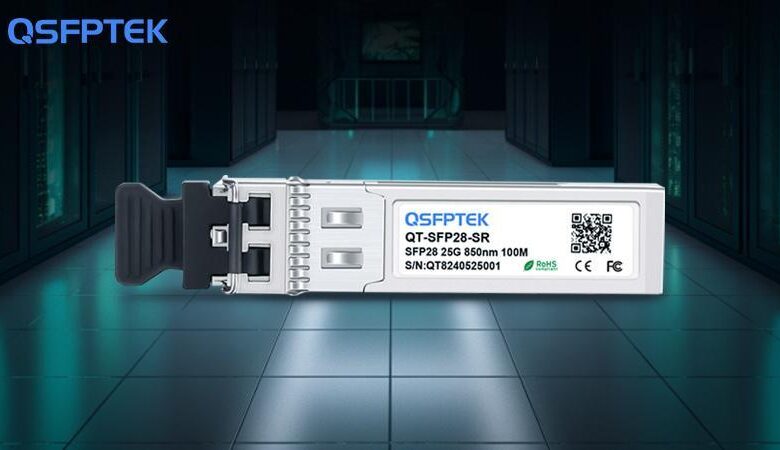Understanding 25GBASE-SR Optical Modules: A Key to Efficient Data Center Networking

As data centers continue to evolve, the need for faster, more efficient, and scalable networking solutions becomes crucial. One such innovation is the 25GBASE-SR optical module. Offering a high-speed, cost-effective option for short-range communication, it plays an integral role in modern networking, especially for data centers aiming to optimize their infrastructure without compromising on performance. This blog will delve into the basics of 25GBASE-SR, its technical features, applications, advantages, challenges, and the trends that shape its future.
What is 25GBASE-SR?
The 25GBASE-SR optical module is a short-range optical transceiver based on the IEEE 802.3by standard. Designed to transmit data at 25 gigabits per second (Gbps) over multimode fiber (MMF), it is an ideal solution for high-density environments such as data centers. “SR” stands for “short-range,” indicating that this module is optimized for short-distance communication, typically up to 100 meters using OM4 multimode fiber or 70 meters with OM3.
This module is highly sought after due to its balance between performance and cost, making it a popular choice for network upgrades, particularly for organizations transitioning from 10G to 25G networks.
How Does the 25GBASE-SR Optical Module Work?
At its core, the 25GBASE-SR optical module operates by converting electrical signals from network devices into optical signals that can travel through fiber optic cables. Once the optical signal reaches its destination, it is converted back into electrical form for processing. The use of MMF allows these signals to travel short distances efficiently, making the 25GBASE-SR module a perfect fit for internal data center communication.
Technical Features of 25GBASE-SR
Transmission Distance: The 25GBASE-SR optical module is designed for short-range communication. It supports distances up to 100 meters when used with OM4 fiber and 70 meters with OM3 fiber. This makes it a suitable choice for data center environments, where distances between racks and switches are often limited.
Wavelength and Fiber Type: Operating at a wavelength of 850 nm, the 25GBASE-SR module uses multimode fiber (MMF). This fiber type is cost-effective for short distances and widely used in data centers.
Compatibility: One of the main advantages of the 25GBASE-SR module is its compatibility with existing network infrastructure. Organizations can upgrade from 10GBASE-SR to 25GBASE-SR using the same MMF cabling, minimizing disruption and cost. Additionally, many 25G modules are backward compatible, supporting various legacy networks, which simplifies network transitions.
Applications of 25GBASE-SR
The 25GBASE-SR optical module is widely deployed in several key networking scenarios, including:
Data Center Interconnects: High-density data centers benefit greatly from the 25GBASE-SR module due to its high speed and relatively low cost. It enables efficient communication between servers, storage devices, and switches.
Enterprise Networks: As enterprises continue to migrate to cloud-based infrastructures and virtualized environments, the demand for faster, more efficient networking solutions like 25GBASE-SR has grown. These optical modules ensure smooth data flow and optimal performance in enterprise networks.
Cloud Computing and Web-Scale Networks: Cloud service providers (CSPs) and large-scale network operators also favor 25GBASE-SR modules. Their ability to handle high traffic volumes at cost-effective rates makes them ideal for supporting the demands of cloud applications and services.
Advantages of 25GBASE-SR
Performance: With data transmission speeds of up to 25 Gbps, the 25GBASE-SR module delivers a significant performance boost over 10G optical modules. This increased bandwidth is essential for applications that require low-latency, high-throughput data transfers, such as virtualization, cloud services, and big data processing.
Cost-Effectiveness: One of the major selling points of the 25GBASE-SR module is its affordability. Compared to 40G and 100G solutions, 25GBASE-SR offers a much lower cost per gigabit, making it an attractive option for organizations looking to upgrade their network infrastructure without overspending.
Energy Efficiency: 25GBASE-SR modules are more power-efficient than their higher-speed counterparts like 40G and 100G transceivers, which can result in long-term energy savings for data centers.
Challenges and Limitations of 25GBASE-SR
Despite its many advantages, the 25GBASE-SR optical module is not without its challenges:
Distance Limitations: The short transmission range (up to 100 meters) can be a limiting factor for some organizations, particularly those with larger campuses or network requirements that span greater distances.
Upgradability: While 25G offers significant improvements over 10G networks, some organizations may opt to bypass 25G in favor of more future-proof options like 40G or 100G. However, for most data centers, 25G strikes an excellent balance between performance and cost.
Future Trends of 25GBASE-SR
As the demand for faster, more efficient data center networking grows, so too will the adoption of 25GBASE-SR modules. While 40G and 100G are becoming more prominent, the 25G solution remains a key stepping stone for organizations not yet ready for higher-speed implementations. Additionally, innovations in fiber technology and transceiver design will likely push the boundaries of what 25GBASE-SR modules can achieve, further extending their lifespan and relevance in the networking landscape.
Conclusion
The 25GBASE-SR optical module is an essential tool for modern data centers and enterprise networks looking to improve their performance without incurring exorbitant costs. With its speed, cost-efficiency, and compatibility with existing infrastructure, it offers a practical solution for organizations navigating the ever-growing demands of cloud computing, virtualization, and big data.
As technology advances and network needs evolve, 25GBASE-SR is well-positioned to remain a crucial part of the data center ecosystem.



